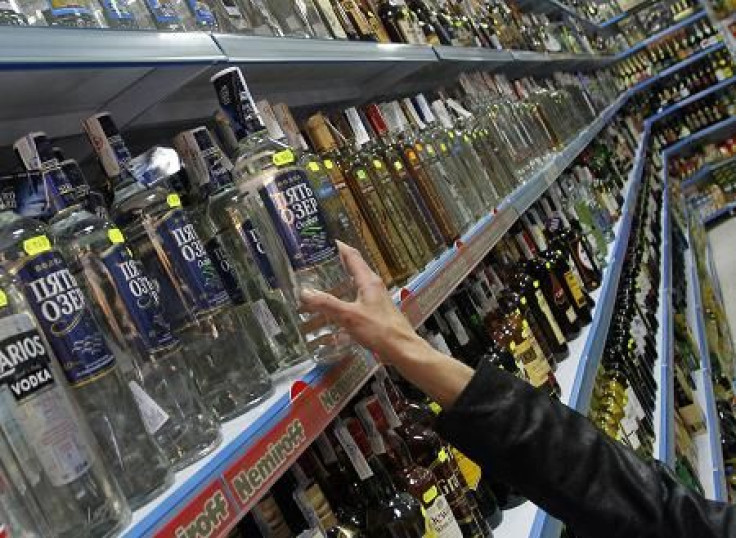Does Capitalism Kill? Not As Much As Vodka

Just after the collapse of the Soviet Union, a strange and tragic affliction took a toll on Russian society: working-age men began drinking themselves to death at alarming rates. Mortality in the new federation surged, contributing to a decline in population that has yet to be reversed.
The causes behind this trend have been hotly debated, but a working paper published this month by the National Bureau of Economic Research has some new ideas about the old scourge. The findings may come in especially handy today, since alcohol abuse still ranks as one of Russia’s most intractable public health issues.
Bottoms Up
Historians called it the Russian Mortality Crisis. Just after the Berlin Wall came down and a privatized economy was gearing up, men in the prime of their lives started kicking the bucket more than ever before. It was clear that the culprit was alcohol: booze-fueled accidents and illnesses surged during the period.
The deeper causes of this trend are complicated. Many academics have accepted the notion that the crisis was precipitated by an economic transition from Communism to capitalism, which left a generation of workers unqualified to compete.
It was a convenient explanation for defenders of the fallen Communist regime: Capitalism kills. But the NBER working paper -- authored by Jay Bhattacharya and Grant Miller, both medical professors at Stanford University, and Christina Gathmann, an economics professor at Germany's University of Heidelberg -- offered a different explanation.
“Rather than the transition to capitalism and democracy, we study the coincident demise of the (reputedly successful) 1985-1988 Gorbachev Anti-Alcohol Campaign,” the report said.
Mikhail Gorbachev was general secretary of the Communist Party from 1985 until its dissolution in 1991. He made it his mission to curb alcohol consumption in the bloc, and the NBER study posits that the program was so successful that its abrupt end spelled big trouble for Russian citizens.
“The campaign was unprecedented in scale and scope -- and it operated through both supply- and demand-side channels, simultaneously raising the effective price of drinking and subsidizing substitutes for alcohol consumption. At the height of the campaign, official alcohol sales had fallen by as much as two-thirds.”
Before the program began to take effect, the level of pure alcohol consumption per capita in the Soviet Union each year was 14 liters. Crunching that number, researchers arrived at the conclusion that the average adult male imbibed an average of one quarter-liter of vodka every day.
The change in consumption spurred by Gorbachev’s efforts to cut down on production and dampen demand is hard to measure, since homemade moonshine production ramped up considerably during that period. But improving mortality rates showed significant progress; it is estimated the campaign saved about 400,000 lives on a yearly basis.
Still, the program was widely unpopular. It officially ended in 1988, though lingering effects of the legislation kept production and demand down for a couple more years. By the early 1990s, found the report, consumption was just as sky-high as it had ever been.
By suggesting that this was more of a "return to normal" than a reaction to capitalism, these findings turn the old assumption about the deaths on its head.
Another Round
And now, here we are again. Alcohol continues to present serious problems for Russia, and leading politicians are taking a page from the Gorbachev playbook.
Russian President Vladimir Putin and Prime Minister Dimitry Medvedev have both worked to curb Russian alcohol consumption, a push that has gone hand-in-hand with anti-tobacco initiatives.
Neither of these powerful men is known to drink heavily, and both are avowed non-smokers. Putin, it seems, prefers to get his kicks from daredevil stunts: shooting tigers with tranquilizers, hunting whales with crossbows, and even mounting a hang glider to guide geese down south during migration season. Medvedev’s leisure activities aren’t as exciting, but he is a bit of a fitness buff who makes time for swimming and yoga whenever possible.
In this case (as in many others) Russia’s leaders are not exactly representative of the general public. A recent report from Euromonitor International found that in 2011, the average Russian citizen drank nine liters of liquor, seven liters of wine and 77 liters of beer. When it comes to vodka in particular, the statistics are even more stark: about 45 percent of worldwide production is consumed by Russians alone.
This boozing has taken its toll. A 2011 report from the World Health Organization found that alcohol-related incidents and illnesses kill about 500,000 people a year. About 23,000 of those deaths are a direct result of alcohol poisoning. Of Russia’s 142 million people, an estimated 2 million are alcoholics.
That’s why Putin and Medvedev have raised taxes on alcohol sales, outlawed retail liquor sales between 11 p.m. and 8 a.m., banned public drinking, and passed strict limits on alcohol advertising.
The verdict is out on whether these measures will work, since any measurable results could take years to make themselves statistically apparent. But if -- as the NBER report maintains -- the Soviet Union was able to effect positive change during the 1980s, perhaps the modern Kremlin can do the same.
© Copyright IBTimes 2024. All rights reserved.












